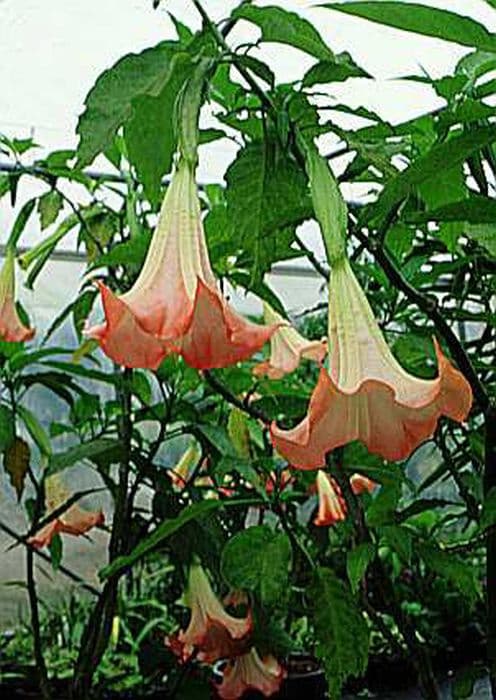Million Bells Calibrachoa Kabloom Series

ABOUT
The Calibrachoa Kabloom Series, often referred to as "million bells" due to its abundant blossoms, features a cascade of petite, bell-shaped flowers. These blossoms boast a variety of vibrant colors, including shades of pink, yellow, purple, red, and orange, as well as bicolored patterns, which add to their visual interest. The petals possess a velvety texture and are slightly fused at the base, creating a trumpet-like form that's characteristic of the plant. This floral display sits atop dark green, compact foliage, with small and somewhat ovate leaves that provide a lush background for the prolific blooms. The overall impression of the million bells is one of a cheerful and colorful plant that can provide a continuous spectacle of flowers.
About this plant
 Names
NamesSynonyms
Million Bells, Mini Petunia
Common names
Calibrachoa Kabloom Series
 Toxicity
ToxicityTo humans
The Calibrachoa, commonly referred to as "Million Bells," is not generally considered toxic to humans. There are no significant toxic effects reported for humans regarding ingestion or contact with the Calibrachoa Kabloom series. Therefore, accidental consumption of this plant is not expected to cause poisoning or serious health issues. However, it is always advisable to keep plants out of the reach of small children who might chew on them out of curiosity.
To pets
Million Bells, known scientifically as Calibrachoa, are not known to be toxic to pets such as dogs and cats. The ASPCA does not list Calibrachoa as a toxic plant for pets. Therefore, ingestion of this plant by dogs or cats is not expected to result in major illness or significant symptoms related to toxicity. However, as with any non-food plant, ingestion in large amounts may cause gastrointestinal discomfort or other non-specific symptoms, so monitoring of pets around houseplants is still a good practice.
 Characteristics
CharacteristicsLife cycle
Annuals
Foliage type
Semi-deciduous
Color of leaves
Green
Flower color
Varies
Height
6-12 inches (15-30 cm)
Spread
12-24 inches (30-60 cm)
Plant type
Herb
Hardiness zones
9
Native area
South America
Benefits
 General Benefits
General Benefits- Continuous Blooming: Calibrachoa Kabloom Series flowers prolifically throughout the growing season without the need for deadheading.
- Wide Color Range: Offers a variety of vibrant hues, giving gardeners and landscapers numerous design options.
- Easy to Grow: This plant is known for being low-maintenance, ideal for both novice and experienced gardeners.
- Attracts Pollinators: The blooms attract butterflies and hummingbirds, promoting biodiversity in the garden.
- Use Versatility: Suitable for hanging baskets, containers, and as a groundcover, providing flexibility in garden design.
- Drought Tolerance: Once established, it has a degree of drought tolerance, reducing the need for frequent watering.
- Compact Growth: Features a mounded growth habit, which helps to keep gardens looking tidy without aggressive spreading.
- Frost Tolerance: Exhibits a level of frost resistance, which can extend the flowering season in cooler climates.
 Medical Properties
Medical PropertiesThis plant is not used for medical purposes.
 Air-purifying Qualities
Air-purifying QualitiesThis plant is not specifically known for air purifying qualities.
 Other Uses
Other Uses- Educational Tool: Calibrachoa is often used in educational settings like biology classes to demonstrate plant growth, hybridization, and genetic diversity within species.
- Photography Subjects: Due to their bright and various colors, Calibrachoa flowers are popular among photographers looking for vibrant, natural subjects.
- Art Inspiration: Artists may use Calibrachoa as a subject for paintings, drawings, or textile designs, inspired by their vivid colors and patterns.
- Therapeutic Gardens: These flowers can be included in therapeutic garden designs which aim to provide a calming and restorative environment for individuals experiencing stress.
- Event Decor: Calibrachoa can be used to create living walls or floral displays for events, adding a touch of elegance and natural beauty.
- Culinary Decoration: While not edible, Calibrachoa flowers can be used as non-toxic decorative elements on dishes in high-end culinary presentations.
- Fauna Attraction: Planting Calibrachoa can attract beneficial insects like bees and butterflies, which are important for pollination in gardens.
- Miniature Gardens: Their small size makes Calibrachoa particularly well-suited for fairy gardens or other miniature garden settings.
- Color Therapy: The vibrant colors of Calibrachoa may be used in color therapy practices to influence mood and emotional well-being.
- Container Gardening Education: These versatile plants are ideal for teaching container gardening techniques due to their adaptability to pots and hanging baskets.
Interesting Facts
 Feng Shui
Feng ShuiThe Calibrachoa, commonly known as Million Bells, can be used in Feng Shui to attract positive energy and enhance areas of your garden or home. In Feng Shui, flowers are often utilized to bring in happiness, good luck, and fresh chi. Their vibrant colors can be used to activate specific sectors according to the bagua map. For instance, placing red or purple Million Bells in the south can ignite fame and reputation, while pink flowers may be positioned in the southwest to support love and marriage.
 Zodiac Sign Compitability
Zodiac Sign CompitabilityThe Calibrachoa, commonly known as Million Bells, is not used in astrology practice.
 Plant Symbolism
Plant Symbolism- Perseverance: The Calibrachoa Kabloom, commonly known as "Million Bells," often symbolizes perseverance due to its robust growth pattern and continuous bloom throughout the growing season.
- Abundance: With its prolific flowering, Million Bells represents abundance and generosity, reflecting its fullness and rich display of colors.
- Gratitude: This plant can be a symbol of gratitude, given as a gift to express appreciation, with its numerous blooms signifying the many thanks to be given.
- Adaptability: Known for its adaptability to a variety of conditions, Million Bells can signify flexibility and the ability to thrive in different environments.
- Joy and Celebration: The bright and colorful flowers of the Million Bells evoke feelings of happiness and are often used in celebratory events, symbolizing joy and festivity.
 Water
WaterCalibrachoa, or 'Million Bells,' should be watered when the top inch of soil feels dry to the touch. Typically, this means watering at least once a week, but during hot, dry periods, they may need water more frequently. It's essential to provide a thorough soaking, so for a hanging basket or container, this could mean using approximately 16-32 ounces of water, depending on the size of the container and the environmental conditions. Avoid overhead watering to reduce the risk of disease, and make sure pots have good drainage to prevent waterlogging.
 Light
LightMillion Bells thrive in full sunlight, which means they should be placed in a location where they can receive at least six to eight hours of direct sunlight a day. An east or south-facing garden spot is typically ideal for these plants to flourish. They will perform less vigorously in shaded or partially shaded areas.
 Temperature
TemperatureMillion Bells prefer warmer temperatures and thrive best when the temperature is between 55°F and 65°F at night and between 65°F and 85°F during the day. They can survive minimum temperatures down to 35°F but should be protected from frost. Temperatures exceeding 90°F may stress the plant, so providing some afternoon shade in extremely hot climates can be beneficial.
 Pruning
PruningPruning Million Bells is essential to encourage bushier growth and more blooms. Pinch back the stems every few weeks, especially if the plants start to look leggy. Deadheading is not necessary as they are self-cleaning, but a light trim can rejuvenate an overgrown plant. The best time for a more substantial pruning is in mid-summer, after the first flush of flowers has faded.
 Cleaning
CleaningAs needed
 Soil
SoilMillion bells thrive in well-draining, fertile potting mix with a pH between 5.5 and 6.5. Amend with peat, perlite, and slow-release fertilizer for optimal growth.
 Repotting
RepottingMillion bells should be repotted annually, primarily in spring, to refresh the soil and accommodate root growth.
 Humidity & Misting
Humidity & MistingMillion bells prefer moderate humidity levels but are quite adaptable and do not require specific humidity adjustments.
 Suitable locations
Suitable locationsIndoor
Place million bells in bright, indirect light and ensure good air circulation.
Outdoor
Choose a sunny spot, protect from wind, and maintain moist soil for million bells.
Hardiness zone
9-11 USDA.
 Life cycle
Life cycleThe Calibrachoa Kabloom Series, commonly known as "Mini Petunia," begins as a seed, which with proper warmth and moisture, germinates within 7-14 days. Upon sprouting, it enters the vegetative stage, developing roots and leaves as it absorbs nutrients and light through photosynthesis. As it matures, it enters the flowering stage, showcasing an array of colorful blooms that attract pollinators and facilitate reproductive processes. Following pollination, the plant develops seed pods, completing its reproductive cycle. These seeds can then be dispersed by various means, allowing a new generation of Calibrachoa Kabloom plants to begin the cycle anew. Eventually, as an annual, it reaches the end of its life cycle with the onset of colder weather, having produced seeds for the next season.
 Propogation
PropogationPropogation time
Spring-Early Summer
The most popular method of propagation for the Calibrachoa Kabloom series, commonly referred to as million bells, is through softwood cuttings. This is typically done in late spring or early summer when the plant's growth is most vigorous. To propagate, a healthy, non-flowering stem of about 4 to 6 inches (approximately 10 to 15 centimeters) in length is selected. The lower leaves are removed, and the cut end is dipped in rooting hormone to encourage root growth. The cutting is then placed in a well-draining soil mix and kept in a warm, humid environment with bright, indirect light. The soil must be kept moist but not wet until roots have developed, which usually takes a few weeks. After rooting, the new plants can be transplanted into individual pots or directly into the garden.


![Calibrachoa [Aloha Classic Blue Sky]](/_next/image?url=https%3A%2F%2Fplants-admin.emdemapps.com%2Fimages%2Fplants%2F%2Fimages%2F604b636c3778b.png&w=640&q=75)
![Calibrachoa [Aloha Classic Gold]](/_next/image?url=https%3A%2F%2Fplants-admin.emdemapps.com%2Fimages%2Fplants%2F%2Fimages%2F604b6284c573e.png&w=640&q=75)
![Calibrachoa [Aloha Classic Tiki Soft Pink]](/_next/image?url=https%3A%2F%2Fplants-admin.emdemapps.com%2Fimages%2Fplants%2F%2Fimages%2F604b548e0a5ef.png&w=640&q=75)
![Calibrachoa [Cabaret Deep Yellow]](/_next/image?url=https%3A%2F%2Fplants-admin.emdemapps.com%2Fimages%2Fplants%2F%2Fimages%2F604b5f20ca3ef.png&w=640&q=75)
![Calibrachoa [Calibasket Radiant Orange]](/_next/image?url=https%3A%2F%2Fplants-admin.emdemapps.com%2Fimages%2Fplants%2F%2Fimages%2F604b536d43cb2.png&w=640&q=75)
![Calibrachoa [Caloha Classic Blue Velvet]](/_next/image?url=https%3A%2F%2Fplants-admin.emdemapps.com%2Fimages%2Fplants%2F%2Fimages%2F604b604884a75.png&w=640&q=75)
![Calibrachoa [Caloha Classic Honey White]](/_next/image?url=https%3A%2F%2Fplants-admin.emdemapps.com%2Fimages%2Fplants%2F%2Fimages%2F604b5f56e0beb.png&w=640&q=75)
![Calibrachoa [Caloha Classic Yellow Chocolate Ring]](/_next/image?url=https%3A%2F%2Fplants-admin.emdemapps.com%2Fimages%2Fplants%2F%2Fimages%2F604b538aede95.png&w=640&q=75)